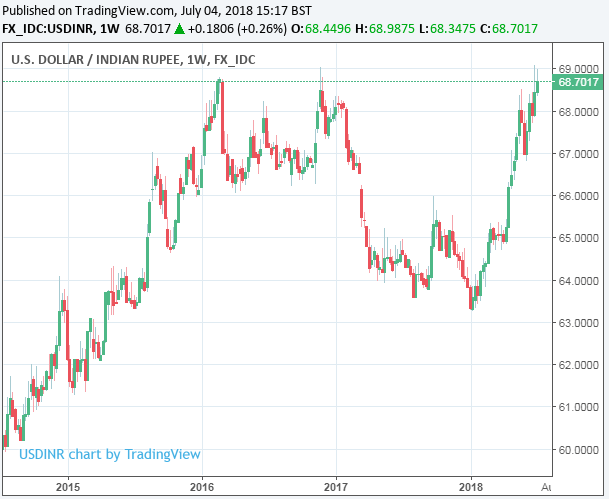The Indian Rupee has Recovery Potential
- Written by: James Skinner
-
- Rupee weakens again as US Dollar continues ascent higher.
- US Dollar and yields close to topping out say Commerzbank.
- Should provide INR respite, pushing USD/INR and GBP/INR lower.

© Adobe Stock
The Indian Rupee might be at its 2019 lows according to the latest forecasts from analysts at Commerzbank, who are arguing that recent pressures on the currency should soon begin to moderate.
India's Rupee has fallen 7.6% against the Dollar and 5.2% against the Pound during 2018, with much of these losses coming in the 11 weeks since the middle of April, as investors fled from emerging market currencies in their droves.
A resurgent greenback, which has converted a 4% 2018 loss into a 2.6% gain during the same time period, and rising US bond yields are at the heart of these moves. A 16.7% increase in oil prices has also driven inflation higher, hampering the currency and threatening economic growth.
The stronger Dollar and higher US yields are bad for emerging market currencies like India because much of the debt in developed world economies is denominated in US Dollars and the interest rates on those debts are indirectly tied to US bond yields. Put differently, a strong Dollar makes emerging market debt more expensive to service and so raises the risk of default while also crimping growth.

Above: USD/INR rate shown at weekly intervals.
The Commerzbank FX team say the various factors that have driven the Rupee depreciation should soon begin to dissipate, providing the currency with some breathing space.
"In our baseline scenario, however, we assume that US yields have peaked and oil prices to moderate by year-end. Thus, INR has recovery potential against the USD, especially as the Reserve Bank of India is ready to deliver more hikes in order to keep inflation in check," says Elisabeth Andreae, an analyst at Commerzbank.
The Reserve Bank of India (RBI) raised its interest rate for the first time since 2014 back in June, taking it up by 25 basis points to 6.25%, in a move that surprised the market. Out of 44 analysts included in a Bloomberg poll only 14 of them had predicted a rate hike in June. One of those correct analysts is now forecasting a continued cycle of interest rate rises over the next year.
"With the economy looking strong and core inflation picking up, we think today’s hike marks the start of a modest tightening cycle. In all, we expect the repo rate to be hiked by a further 50bp to 6.75% over the next six months or so," writes Shilan Shah, a senior India economist at Capital Economics, in a note after the June RBI rate rise.
RBI policy makers said the decision to raise rates was due to a worsening outlook for inflation, which has been lifted not only by the double-digit 2018 increase in oil prices but also by the fall in the Rupee, which has made imported goods much more expensive for companies and consumers to buy. Indian consumer price inflation rose from 4.3% in March to 4.6% in April and 4.9% in May, which is far above the 4% target of the RBI.
"However, INR's appreciation potential is limited by continuing concerns about globally increasing protectionism. The associated risk-off sentiment is exerting devaluation pressure, especially in Emerging Market currencies," says Andreae.
Above: Pound-to-Rupee rate shown at weekly intervals.
President Trump is pursuing restrictive legislation to govern Chinese investments into the United States and has recently ordered that a range of tariffs be levied against imports of more than $250 billion in American imports of Chinese goods.
The move has drawn retaliation and threats of even further reciprocal measures from the Chinese, which all comes on top of earlier White House tariffs on imports of steel and aluminium into the United States from across the globe, including the European Union.
The EU has since responded to those with its own levies on US motorcycles, jeans and whiskey, drawing threats of even more tariffs from the White House, this time targeting the mighty European automotive sector. Fears are that a tit-for-tat tariff spat will fast descend into an all out global "trade war" that dents global growth, particularly in emerging markets.
"This is where the main risks for our forecast lie. Apart from this, the gradually tighter US monetary policy and the comparatively higher inflation trend in India argue in the medium term for a moderate INR devaluation," Andreae adds.
Andreae and the Commerzbank FX team predict the Rupee will recover a modest amount of its losses against the Dollar during the rest of 2018 before undergoing a renewed but modest depreciation in 2019. They forecast the USD/INR rate will decline to 67.50 before year-end, before rising back to 68.0 over the course of 2019.
The Pound-to-Rupee rate is predicted to fall to 89.18 before the end of 2018 before rising to 93.19 during the 2019 year.
Advertisement
Get up to 5% more foreign exchange by using a specialist provider to get closer to the real market rate and avoid the gaping spreads charged by your bank when providing currency. Learn more here
